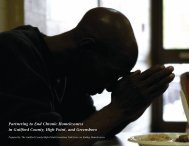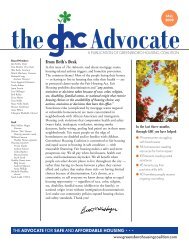data - Greensboro Housing Coalition
data - Greensboro Housing Coalition
data - Greensboro Housing Coalition
Create successful ePaper yourself
Turn your PDF publications into a flip-book with our unique Google optimized e-Paper software.
Chapter 1<br />
Introduction<br />
This report is the fourth Annual Homeless Assessment Report (AHAR) and the first to<br />
provide year-to-year trend information on the prevalence of homelessness nationwide, the<br />
demographic characteristics of homeless people, and the way homeless people use the<br />
residential services system. The report provides the latest counts of homelessness<br />
nationwide—including counts of individuals, persons in families, and special population<br />
groups such as veterans and persons experiencing chronic homelessness. The report also<br />
covers the types of locations where people use emergency shelter and transitional housing;<br />
where people were just before they entered a residential program; how much time they spent<br />
in shelters over the course of a year; and the size and use of the U.S inventory of residential<br />
programs for homeless people.<br />
This report breaks new ground by being the first AHAR to compare annual sheltered counts<br />
from year to year. It is also the first report to compare Point-in-Time (PIT) counts across<br />
multiple years. These comparisons are useful for several reasons. First, the comparisons<br />
suggest whether homelessness is increasing or decreasing nationwide and thus help to gauge<br />
whether the nation’s policy responses are making progress toward preventing and ending<br />
homelessness. They also suggest how the portrait of homelessness—or the demographic<br />
composition of the homeless population—may be changing over time. This understanding<br />
helps both policymakers and practitioners to target particular homeless subpopulations that<br />
need additional assistance. Finally, annual comparisons reveal how shelter use patterns may<br />
be fluctuating, which, in turn, may prompt funding reallocations to support programs that are<br />
in high demand.<br />
1.1 History of the AHAR<br />
At the direction of Congress, the U.S. Department of <strong>Housing</strong> and Urban Development<br />
(HUD) created uniform national <strong>data</strong> definitions for local Homeless Management<br />
Information Systems (HMIS), instructed programs receiving HUD McKinney-Vento funding<br />
to report to those systems, and encouraged all programs for homeless people—regardless of<br />
their funding source—to report <strong>data</strong> to the HMIS. HMIS implementations have grown<br />
stronger over the past several years and, recognizing their usefulness for local planning and<br />
policy-making, an increasing number of emergency shelters and transitional housing<br />
programs participate in an HMIS. Emergency shelters and transitional housing programs are<br />
the primary providers of residential services to homeless persons.<br />
Six years ago, HUD established a nationally representative sample of communities and began<br />
working with those and other communities willing to provide their HMIS <strong>data</strong> to produce<br />
unduplicated estimates of users of emergency shelter and transitional housing. An<br />
Introduction 1




